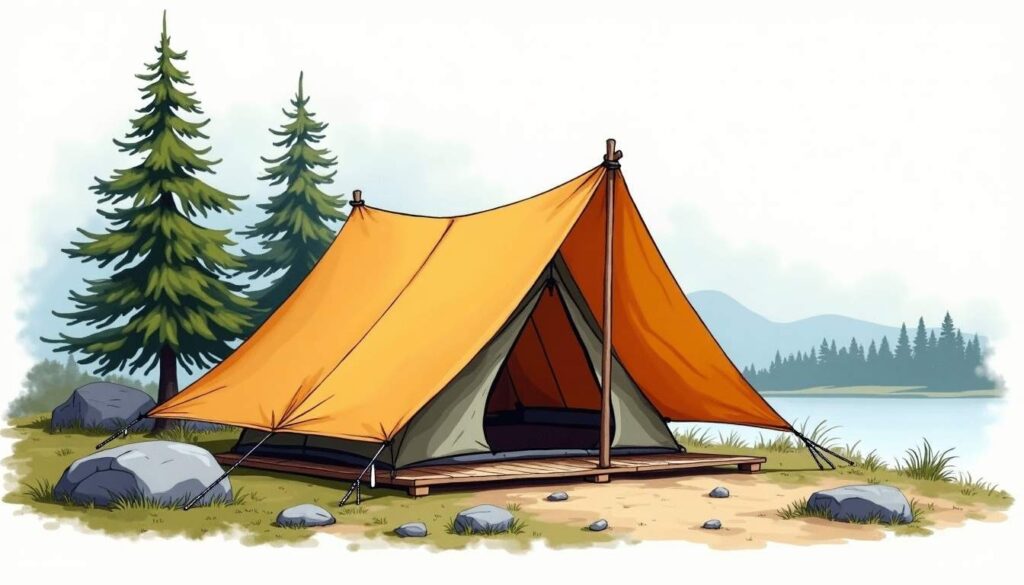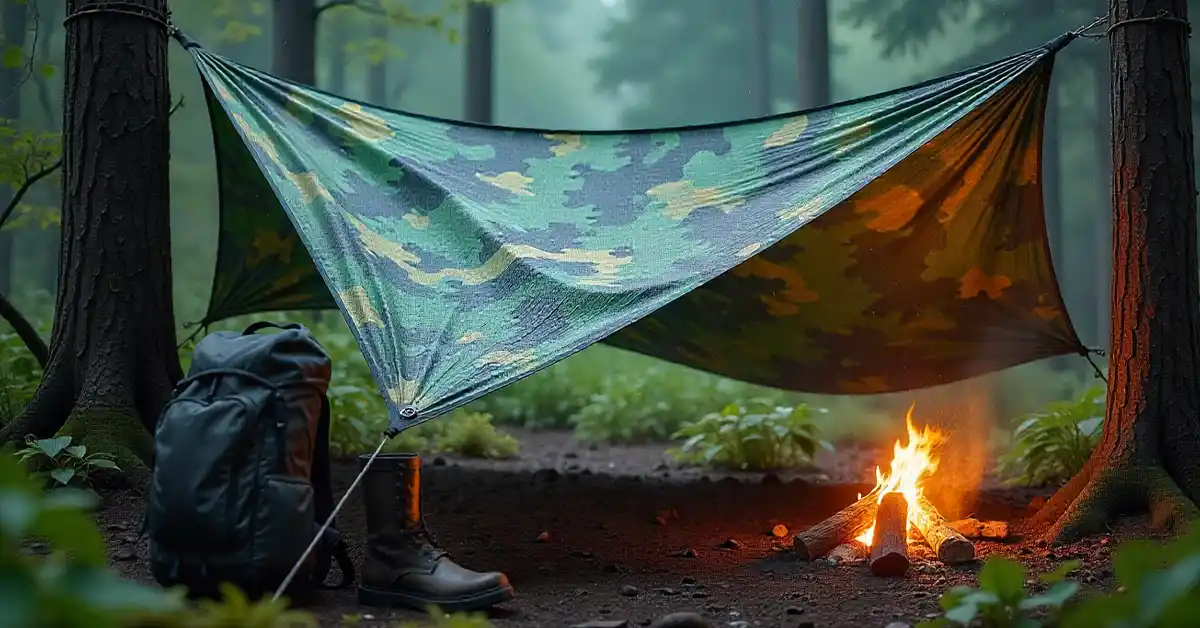Imagine you’re out in the open, rain starts pouring unexpectedly, or the sun beats down relentlessly. Having the right cover can make all the difference. That’s where a tarnplanen comes in-a versatile, durable tarp designed to protect you and your gear from the elements.
This guide dives deep into what tarnplanen are, how to choose the best one, and practical tips for using them effectively. Whether you’re camping, working outdoors, or just need reliable protection, understanding tarnplanen is essential.
What Exactly Is a Tarnplanen?
A tarnplanen is essentially a tarp, but not just any tarp. The term originates from German military usage, where it referred to camouflage tarps used to conceal equipment and personnel. Today, tarnplanen are widely used in outdoor activities, construction, and emergency situations.

Unlike basic tarps, tarnplanen are often made from heavy-duty materials like reinforced polyethylene or canvas. They’re designed to be waterproof, UV resistant, and tear-proof. Some feature camouflage patterns, while others come in solid colors for general use.
Key Features of Tarnplanen
Durability is the hallmark of a good tarnplanen. They typically have reinforced edges with grommets spaced evenly around the perimeter for easy securing. This makes them adaptable to various setups—whether you’re creating a shelter, covering equipment, or lining a ground area.
Water resistance is another critical feature. Tarnplanen are coated or laminated to repel water, keeping whatever’s underneath dry even during heavy rain. Additionally, many have UV protection to prevent sun damage and fading over time.
Another noteworthy aspect of tarnplanen is their versatility. They can be used in a multitude of scenarios, from camping trips and outdoor festivals to construction sites and emergency preparedness kits. For instance, campers often use them as ground covers to provide a barrier between the damp earth and their sleeping bags, while also serving as a makeshift rain shelter when strung between trees. In construction, they can protect materials from the elements, ensuring that everything remains intact and usable.
Moreover, the camouflage patterns of tarnplanen are not just for aesthetics; they serve a practical purpose in blending into natural surroundings. This feature is particularly beneficial for hunters and wildlife photographers who wish to remain inconspicuous. The effectiveness of these patterns can significantly enhance the user’s experience in outdoor environments, allowing for a more immersive and successful outing. With their combination of functionality and adaptability, tarnplanen have become an essential tool for anyone who spends time in nature or requires reliable protection for their gear.
Choosing the Right Tarnplanen for Your Needs
Not all tarnplanen are created equal. Selecting the right one depends on what you plan to use it for, the environment, and your budget.

Material Matters
Polyethylene is the most common material for tarnplanen. It’s lightweight, waterproof, and affordable. However, it can be less durable over time, especially if exposed to harsh conditions continuously. This makes polyethylene tarps ideal for temporary setups, such as covering firewood or protecting outdoor furniture during a rainstorm.
Canvas tarps, on the other hand, are heavier and more expensive but offer superior durability and breathability. They’re better suited for long-term use or situations where you need a tarp that can withstand rough handling. Additionally, canvas tarps can be treated with waterproofing agents, making them suitable for various applications, from camping to construction sites, where a robust and reliable cover is essential.
Size and Weight Considerations
Think about the size of the area or items you need to cover. Tarnplanen come in various sizes, from small sheets perfect for backpacks to massive covers for vehicles or large equipment. A tarp that’s too small won’t provide adequate protection, while one that’s too large can be cumbersome to handle. It’s also beneficial to consider the shape of the items you’re covering; a rectangular tarp may not fit well over a round object, so measuring your gear beforehand can save you from unnecessary hassle.
Weight is also a factor, especially if you’re carrying your tarnplanen on hikes or camping trips. Lightweight tarps are easier to pack but may sacrifice some durability. Conversely, heavier tarps can be more challenging to transport but often provide better resistance against tearing and wear. For those who prioritize portability without compromising on strength, consider looking for tarps made from high-denier fabrics that offer a good balance between weight and durability.
Camouflage vs. Solid Colors
If concealment is important—say, for hunting, military exercises, or wildlife observation—opt for a tarnplanen with a camouflage pattern. These blend into natural surroundings and reduce visibility. Many camouflage options are specifically designed to mimic local flora, enhancing their effectiveness in various terrains, whether it’s dense woods or open fields.
For general use, solid colors like green, blue, or gray are common. They’re versatile and often less expensive. Solid tarps can also be used creatively; for instance, they can serve as makeshift backdrops for outdoor events or be utilized in DIY projects like creating shade structures or windbreaks. When choosing a color, consider how it will fit into your overall setup and whether it will blend or stand out, depending on your specific needs.
How to Use Tarnplanen Effectively
Knowing how to set up and secure your tarnplanen can make a big difference in its performance. Here are some practical tips to get the most out of your tarp.
Creating a Shelter
One of the most popular uses for a tarnplanen is as a makeshift shelter. You can rig it between trees or poles using ropes or paracord through the grommets. Adjust the height and angle to protect against wind and rain direction. When setting up your shelter, consider the terrain and the potential for falling branches or debris. Position your tarnplanen in a way that allows for adequate drainage, ensuring water doesn’t pool on top. Additionally, using trekking poles can provide a versatile and lightweight option for creating a tent-like structure, allowing for more headroom and comfort.
For ground protection, lay the tarnplanen flat to create a dry, clean surface. This is especially useful under tents or sleeping bags to prevent moisture from seeping through. If you’re camping in an area with rocky or uneven ground, consider layering additional materials such as leaves or pine needles beneath the tarp for added cushioning and insulation. This not only enhances comfort but also helps to extend the life of your tarnplanen by reducing wear and tear.
Covering Equipment and Supplies
When working outdoors, covering tools, machinery, or firewood with a tarnplanen keeps them dry and protected from dust and debris. Secure the tarp tightly using bungee cords or ropes to prevent it from flapping in the wind. It’s also wise to choose a tarp with UV-resistant properties if you plan to leave equipment covered for extended periods, as this will help prevent degradation from sun exposure. Additionally, consider using multiple tarps to create a layered protection system, especially for sensitive equipment that may require extra care.
Emergency Uses
In emergencies, a tarnplanen can serve as a signaling device if it has bright colors or reflective strips. It can also be used to collect rainwater or as a stretcher in rescue situations. In survival scenarios, the versatility of a tarnplanen is invaluable; it can be fashioned into a makeshift poncho or raincoat by cutting holes for your head and arms, providing essential protection from the elements. Furthermore, if you find yourself in a situation where you need to start a fire, the tarp can also be used to create a windbreak, allowing you to build a more effective fire that can provide warmth and cooking capabilities.
Maintenance and Care Tips
Proper care extends the life of your tarnplanen, ensuring it remains reliable when you need it most.

Cleaning Your Tarnplanen
After use, especially in muddy or dusty environments, clean your tarp with mild soap and water. Avoid harsh chemicals that can degrade the material. Let it air dry completely before folding to prevent mold and mildew.
Storage Recommendations
Store your tarnplanen in a cool, dry place away from direct sunlight. Folding it loosely rather than tightly can help prevent creases and damage to the coating.
Repairing Minor Damage
Small tears or holes can be patched with tarp repair kits or heavy-duty adhesive tape designed for outdoor fabrics. Addressing damage promptly prevents it from worsening.
Popular Tarnplanen Brands and Where to Buy
Several brands specialize in high-quality tarnplanen, offering a range of sizes and materials to suit different needs.
Reliable Brands to Consider
Brands like Helikon-Tex and Rothco are known for their military-grade tarps with excellent durability and camouflage options. For more general outdoor use, companies like Amazon Basics and Ozark Trail offer affordable polyethylene tarps suitable for casual users.
Shopping Tips
When purchasing a tarnplanen, check product reviews and specifications carefully. Look for features like reinforced corners, waterproof ratings, and UV resistance. If possible, buy from reputable outdoor or military surplus stores to ensure authenticity and quality.
Final Thoughts on Tarnplanen
A good tarnplanen is more than just a tarp-it’s a versatile tool that can protect, conceal, and assist in countless outdoor scenarios. Understanding the different types, features, and uses helps you make an informed choice that fits your lifestyle.
Whether you’re an avid camper, a professional working in rugged environments, or someone preparing for emergencies, investing in a quality tarnplanen pays off. It’s a simple piece of gear that offers peace of mind and practical benefits whenever the weather or situation calls for it.


